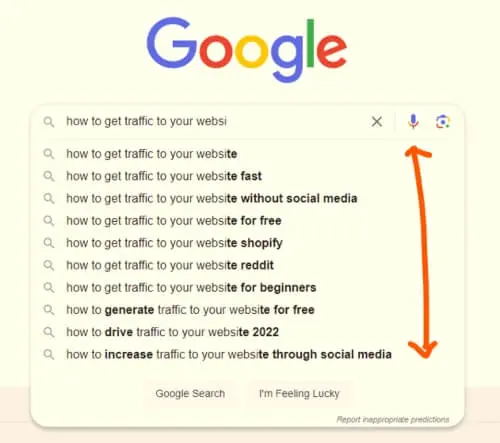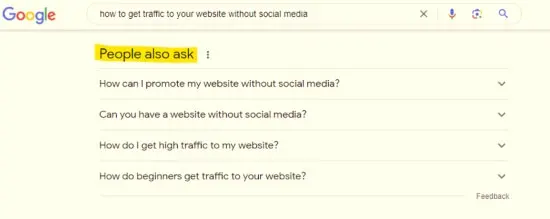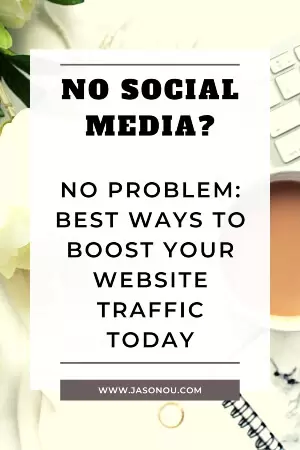How To Get Traffic To Your Website Without Social Media
It’s no secret that social media is a powerful tool for marketing.
However, what if you don’t have the time or resources to use social media? Or, what if you hate it? In this article, we will explore eleven ways to get traffic to your website without social media.
But First …
Although I have a love-hate relationship with social media, I recommend you should do everything possible to promote your website.
Tweet it, pin it, like it, go live, share it, comment about it, and plug it on social to widen your reach.
And …
Why Not Just Throw A Bunch Of Money For Ads?
Paid advertising is a quick way to get traffic to your site. But, it’s not always the most cost-effective option, especially for small businesses or bloggers with limited budgets.
They can quickly become expensive, and they’re not always sustainable in the long run.
And paying for traffic every month can put many small businesses off.
That is why many bloggers (and small businesses) rely on organic traffic from search engines, social media, and other sources.
It may take longer to build up that traffic, but it will be more sustainable in the long run.
Paid ads can be one good way to get some initial traffic, but they’re not the best long-term solution for most bloggers.
With that said, let’s look at :
P.S Need help with starting a blog – from branding to launching a blog?
You can reach out to me here for help and let’s talk.
How to Get Traffic To Your Website Without Social Media : 11 Steps
This page have some affiliate links. In other words, if you buy from my links, I may get a commission. And some of the images were sources from Unsplash+ (Getty Images, Nick Morrison).
1. Focus on The Right Content
If you’re running a website or blog, content is key.
Without high-quality content, you won’t be able to attract the right readers or get the attention of search engines.
That’s why it’s important to create content that matches the search intent.
Write content that is interesting and informative, and focus on topics that are relevant to your audience.
By doing this, you’ll be able to attract the right readers and keep them coming back for more.
And don’t forget to optimize your content for search engines.
Add the keywords in the meta-title, meta-description, introduction, sub-headings, in the body and the end of the article.
2. Know Your Target Audience
Which helps you better understand what kind of solutions they are looking.
Then you give them what they want. And that is through killer content that speaks directly to your ideal customer.
So before you start writing, take some time to get to know your target persona.
You may be surprised at how much it can help.
3. Know Your Topic
Creating great content is essential.
That’s because Google, and other search engines, reward websites that publish high-quality, in-depth articles.
The better you understand a subject, the more value you can share.
Not only does the content on your website matter for Google, but the links to other websites from yours shape how credible your site is.
And the more authority your articles have, the higher it will likely rank in search results.
Of course, you don’t need to be an expert on every topic related to your niche.
But it is important to have a good understanding of the topics you do write about.
One way to ensure that you know your topic inside out is to keep up with the latest news and developments.
This way, you can be sure that your content is always fresh and relevant.
Another way to become an expert on your chosen topics is to read widely about them.
Not only will this help you to develop a better understanding, but it will also give you ideas for new content.
Know your topic well so that your articles are deep and thorough.
4. Feast off the Big Elephants
You know those birds that hitch a ride of those majestic elephants and help themselves to a buffet of ticks and parasites.
Sounds gross.
But. When I run out of blog ideas I often check out the big elephants in the niche and feast off the keywords they may overlook.
It works like this.
You use a tool like SE Ranking. Pick the big elephant and then reverse engineer their website.
This will give you an insight into what topics they rank for and what long-tail keywords you can target.
With this information, you can write blog posts that are related to these topics and maybe target the same keywords.
You could even attract more readers, by writing about subtopics that are related to the larger topics.
This will help you branch off and explore new ideas while still staying within your niche.
Say, you’re in the personal loan industry. You see a competitor ranking for the term, ‘personal loan rates’. Within that topic, you could write a post on, ‘Best Personal Loan Rates in Florida’.
However, it’s equally important that the keywords you’re targeting have decent search volume and that the competition isn’t too high.
Otherwise, you will struggle to rank in Google.
5. Focus on One Topic
I love taking my kids to the library. And it’s such a great place to inspire them to read and write.
All the books and resources are organized in categories from History, Finance, Fiction and so on.
Which makes it so easy to find what you want.
Without a proper layout, I don’t think I can find the information I need.
When it comes to your content, you have to ensure your website is organized and structured so that users and search engines will find it easy to navigate and understand.
To begin with focus on one topic as it helps to keep your website organised.
Say, you have a home improvement blog. You would want to group all your content on home decor.
Within that group of articles, there would be articles about topics from minimalist home decor, rustic home decor, and home decorating ideas.
By grouping content together with similar topic or theme, your audience will have an easier time finding information.
As well, when you focus your attention on one topic, it can establish your brand and expertise with your readers and in turn boost your website’s topical authority and ranking with Google.
6. Leveraging Long Tail Keywords for Website Traffic
You just don’t want traffic. You want targeted traffic.
Since the traffic will be more specific, competition will be low, and more likely anyone visiting your website will convert.
By focusing on long-tail keywords, you can rank higher in search engine results pages (SERPs) and drive more relevant traffic to your website.
For example, a general keyword like “shoes” is much too broad and way too competitive.
But a long-tail keyword like “women’s size 10 black heels” is much more specific and therefore more likely to result in a sale.
Think about it. It’s how most of us will search online.
Personally, I’m not into women’s shoes.
But, if I wanted organic traffic to my website, I would type in “How To Get Traffic to Your Website Without Social Media“.
To dig out those long tail keywords, you can use a keyword research tool like Google Keyword Planner or SE Ranking.
Just enter a seed keyword into the tool, and it will return a list of long-tail keywords related to that keyword.
You can even use Google Autocomplete.
All you need to do is.
Enter a keyword like “How to get traffic to your website” like so below. And see what other related searches pop under it.
Guess what. I can see a nice long tail keyword like how to get traffic to your website without social media!
For even more long tail keywords, check out the ‘People Also Ask’ and take advantage of those big important questions.
Once you have a list of those long-tail keywords, plug them into your favorite keyword tool.
And if it looks good, start incorporating them into your blog (more on this soon) so you can increase website traffic without social media.
But don’t over-stuff your keywords; instead, use them naturally so your content is still readable.
You can gain a competitive edge by targeting the lesser keywords that your larger competitors may overlook.
Furthermore. You avoid going head-to-head with the more established websites just by being small and nimble with your approach.
This is why keyword research is important for your blog.
7. On-Page SEO
Optimizing your site for Google is a great way to increase your visibility and reach more people.
Most importantly, you need to generate content that perfectly satisfies what the searcher is looking for.
Your content needs to be relevant and informative so your readers will stay engaged on the website.
Simply stuffing keywords into your content won’t cut it.
And, your website’s content must be optimized for search engine optimization.
This means optimizing your website with the correct keywords in the following areas:
Meta title, meta description, header tags, content (introduction, body and summary), image file names, image alt tags, and the URL Slug.
And even start a Frequently Asked Question (FAQ) section.
(I go more in-depth on the on-page SEO stuff in this blog about the best blogging SEO practices. Feel free to check it out.)
8. Get Referral Traffic
You’ve done all the above, like researching, creating content that matches the search intent, and optimizing the content with long tail keywords.
The work doesn’t stop there.
Now it is time to get traffic to your website without social media.
To do this, you need to get links from high-traffic niche websites because it can help with both traffic and SEO.
This is handy when you can get traffic to your website from the traffic of those websites.
Here’s the process of how to get those links:
- Identify high-traffic niche websites and influencers in your industry or related industries.
- Research the websites and see if there is a gap you can fill or add value to.
- When you write a post, link to the websites.
Reach out to the site owners or editors and let them know you have linked to their website.
Which could lead to a few possibilities …
- You land on their radar and get one foot into the door.
- Creating goodwill between you and the website owner.
- They share your content on their platforms. If they have an audience on social or other networks, they may share the content.
- A link back to your website or blog is not only an acknowledgment of your content, but it can also result in referral traffic.
But don’t stop there.
Continue to foster a relationship.
You never know, it can lead to other opportunities for guest posting, interviews, and more.
9. Guest Blogging
Understanding Backlinks and Their Importance
Backlinks, also known as inbound links, are links from one website to a page on another website.
They play a crucial role in SEO because search engines like Google see them as a vote of confidence from one site to another.
High-quality backlinks, especially inbound links from trusted sources, signal to search engines that your content is valuable and trustworthy.
This can lead to higher rankings in search engine results, which in turn can drive more traffic to your website.
And one effective way to build high-quality backlinks is through guest blogging.
This involves writing articles for other websites in your industry and including links back to your site
On top of that. It can be a powerful way to get traffic from big websites as it can help establish your brand.
Here are some tips on how to get started with guest blogging:
- Find blogs in your niche that accept guest posts. You can do a search query in Google like “your niche + guest post” or “niche keyword _ write for us” to find guest blogging opportunities
- Reach out to the blog owner and pitch them an article idea that would be a good fit for their website. You can improve your chances of getting accepted if you have previous guest blogging experience or if you’ve been actively reading, engaging, or even sharing their content.
- Write a high-quality guest post that provides value to their readers. In it, you can include a link to your website or blog. This will help get traffic to your site.
- Share your guest post on social media to promote it
And the more you do it, the easier it’ll become.
And the more quality articles you write, the more people will begin to know and trust your name. People may even come looking for you instead of the other way around.
Guest blogging can be a great way to get traffic and exposure for your website.
If you do this right, it can also help establish your brand and build relationships with other bloggers in your niche.
The Long-Term Benefits of High-Quality Backlinks
The benefits of building high-quality backlinks extend beyond immediate increases in website traffic.
Over time, these backlinks can help you build a strong online reputation and establish your site as an authoritative source in your industry.
This can lead to sustained growth in organic traffic, as people are more likely to find and trust your content.
One more thing. High-quality backlinks can improve your site’s overall user experience by providing readers with valuable additional resources.
In summary, high-quality backlinks are a vital component of SEO strategy, and building them through guest posting and content promotion can lead to increased website traffic and long-term success.
10. Go Viral
What makes a piece of content go viral? Great question. There is no one answer, but there are some key ingredients.
First, the content must have true value for the reader. Some of the features of viral content:
- It must be shareable: People must want to share it with their friends and followers.
- It must be interesting: It should capture peoples attention and keep them engaged.
- It must be useful: It should provide value to the reader, whether thats information, entertainment, or both.
- It must be timely: It should be relevant to what is happening in the world now.
- It must have a catchy headline: This is what will make people want to click on it in the first place.
- It has original research.
- It includes charts, stats and trends.
- It offers free resources, tools, and software.
- It is funny.
- It should offer something new they have not seen before, or provide a unique perspective on a familiar topic.
Of course, even the most perfectly crafted piece of content will not go viral if no one sees it.
So make sure you are promoting your content across all your channels, from social media to email-marketing
And finally, be patient!
Viral content takes time to catch on and even longer to die down. But, if you play your cards right, you could see your traffic (and conversions) skyrocket.
11. Use Email Marketing to Drive Website Traffic
Email marketing is a powerful tool for driving traffic to your website.
It’s all about building a list of subscribers and keeping in touch with them regularly. This isn’t just about sending promotional emails.
It’s about providing helping your readers, sharing updates, and building a relationship with your audience.
(Using an email autoresponder like Moosend, you can easily automate all your communication in a few simple clicks.)
Here’s why it works:
- Direct Communication: Email allows you to communicate directly with your audience. Unlike social media, where your posts might get lost in a sea of content, email lands straight in your subscribers’ inboxes.
- Personalization: With email, you can personalize your messages based on what you know about your subscribers. This can make your emails more relevant and engaging.
- Control: Unlike social media platforms, you have complete control over your email list. You don’t have to worry about algorithm changes affecting your reach.
Building Your Email List
But. Building an email list takes time and effort, but it’s worth it.
Here are some strategies you can use:
- Lead Magnets: Offer something of value (like a free ebook or a discount code) in exchange for people’s email addresses.
- Sign-Up Forms: Make it easy for people to subscribe to your emails. Include sign-up forms on your website, especially on high-traffic pages.
- Quality Content: If you consistently provide valuable content, people will want to subscribe to your emails so they don’t miss out.
Engaging Your Subscribers
Once you’ve built your email list, the next step is to engage your subscribers.
Here’s how:
- Regular Updates: Send regular emails to keep your subscribers engaged and drive them back to your website. This could be weekly newsletters, new blog post announcements, or special offers.
- Valuable Content: Make sure your emails provide value. This could be useful information, tips, exclusive content, or anything else your subscribers might find interesting or helpful.
- Clear Call-to-Action: Each email should have a clear call-to-action. This could be a link to your latest blog post, an invitation to check out a new product, or anything else you want your subscribers to do.
Remember, the goal of email marketing is not just to drive traffic to your website, but to build a relationship with your audience.
If you can do that, the traffic will follow.
How To Increase Blog Traffic Without Social Media – The Takeaway
Here is a recap on how to get traffic to your website and blog without social media:
- Know your ideal customer.
- Focus on writing content that matches the search intent of the user.
- Optimize your content with the right amount of keywords.
- Scrape for long tail keywords because it will be less competitive.
- Publish shareable content so readers can share it on their social.
- Build a relationship first with websites in your niche before asking for anything.
- Focus on one topic, write content around it and then organize it so users and search engines can easily find information they want.
- Build a list of your best prospects so you can build a solid base of loyal fans.
You got this.
P.S Need help with starting a blog – from branding to launching a blog?
You can reach out to me here for help and let’s talk.
How to Get Traffic To Your Website Without Social Media : FAQS
Still wondering how to get traffic to your website without social media? Below are some common questions laid out and answered.
How can I promote my website without social media?
Absolutely! Boost your website’s visibility by focusing on SEO, guest posting on other blogs, and engaging in email marketing. Offline promotions can also be effective. Additionally, consider participating in relevant forums or online communities. Sharing your expertise can draw people to your website.
How do I increase traffic to my website?
To increase traffic, focus on creating high-quality content that answers your audience’s questions. Optimize your site for search engines and consider guest posting or collaborations. Additionally, make sure your website is user-friendly. A well-designed, easy-to-navigate site can keep visitors coming back for more.
Can you have a website without social media?
Absolutely! While social media can help, it’s not a must. Drive traffic through SEO, email marketing, guest posting, and more. Also, don’t underestimate the power of word-of-mouth. Happy customers can be your best promoters.
Is it OK if I don’t use social media?
Of course, it’s OK! Social media is just one tool in the toolbox. There are many other ways to connect with your audience and promote your content. Remember, the key is to engage with your audience in a way that feels authentic to you.
Is it possible to be successful without social media?
Yes, indeed! Success comes from delivering value to your audience, and there are many ways to do that. Social media is helpful, but it’s not the only path to success. Focus on building strong relationships with your audience, and the success will follow.
Why is my website getting no traffic?
If your website isn’t getting traffic, it might be due to issues with SEO, content quality, or site design. But don’t worry. With some tweaks and a bit of patience, you can turn things around! Start by reviewing your content and making sure it’s valuable and relevant to your audience. And then promote it to get traffic to your website.
How can I improve my website SEO?
To boost your SEO, make sure your site is easy to navigate, use relevant keywords in your content, and ensure your site loads quickly. Also, consider linking to other reputable sites in your field. Remember, SEO is a long-term game. It might take some time to see results, but the effort is worth it!
Final Thoughts on How To Get Traffic To Your Website Without Social Media
The mistake I made early on with blogging was to post content and wait for the traffic to magically come. Dumb.
And you shouldn’t too.
If you want to get traffic to your website without social media, keyword research is the key.
You need to pounce like a lion for those keywords and really grind them down to the bone.
When you have them. Create helpful content for it and then start driving traffic by reaching out to fellow website owners and bloggers in your niche.
Your target market is out there regardless of social media.
In fact, you may discover that your most trustworthy and dependable source of website traffic comes from a platform other than social media.
Anyway. I hope you found this blog on ‘how to get traffic to your website without social media‘ useful.
Feel free to share this post with fellow bloggers who may find this useful.
You Might Want to Check This Out Too
Disclosure: This post may contain affiliate links, which means I’ll receive a commission if you purchase through my links, at no extra cost to you. Please read full disclosure for more information.
Resources To Grow Your Business With
Pinteresting
Struggling to get traffic from Pinterest? Pinteresting Strategies 2025 by Carly Campbell reveals a manual pinning method that works—even with algorithm changes.
This course walks you through step-by-step strategies to pin effectively, increase engagement, and grow your blog without relying on expensive schedulers.
Carly has used this exact system to bring in 100,000+ page views in just months, and now she’s sharing it with you.
Stop guessing and start seeing real results today!
Bluehost
Bluehost is a great starting point for beginners or bloggers who want to switch to a reliable web hosting service. And it gives you the best bang for your buck - starting at $2.95 a month*.
With the entry-level hosting plan, you'll get a high up-time, reliable customer support, FREE domain name (first year) and 30 day money back guarantee.
You can sign up with Bluehost here.
WPX Hosting
It's a web-hosting service I love using. It specializes in WordPress hosting, and depending on what package you opt for, you can host 5 or more sites on one account. The best bit is - the quick turnaround in support is top notch.
For bloggers who have an established blog, this is a fantastic option.
You can learn more about this service here.
Aweber
Building an email list of a growing audience is essential for the longevity of any business. This autoresponder service is easy to use, and it is a great starting point for someone looking to kickstart their email campaign.
Hi, I’m Jason Ou (surname aka, Oh). I am a Solopreneur and Blogger. My mission is to help fellow entrepreneurs (like you) to profit from their passion online. Let’s connect on Facebook now.











